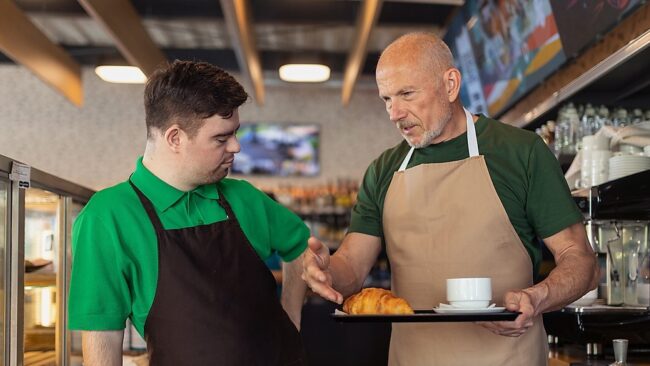Government figures show that more than 100 sheltered employment organisations are active in Flanders alone, providing employment for more than 30,000 people. They play an important social role and strengthen the labour market, and with businesses and other organisations regularly outsourcing activities to them, they are integral to our daily lives. For us as an insurance partner that prioritises sustainable entrepreneurship and diversity and inclusion, supporting this sector represents part of our sustainability mission.
*Source: Statistics Flanders
From individuals with a lifelong disability to political refugees, people doing specially adapted work after a serious traffic accident, and those fulfilling a court-imposed community service order, sheltered employment organisations support a highly diverse public with very different backgrounds and talents.
Mario Vermaelen: ‘The day-to-day activities and management of this mixed group brings with it a number of challenges. These are often to do with communication, due to language barriers for instance, but can also be about work ethic, motivation, experience, etc. What’s more, some employees only work for the organisation on a temporary basis. This makes the importance of continuing training, awareness-raising and coaching even greater than for other organisations.’
A sheltered employment organisation provides customised support and can be brought in for a range of activities, the best-known being:
- Public spaces: maintaining public roads and parks, cleaning bottle banks, cleaning bus shelters and so on, often using light trucks and trailers.
- Packaging: Packaging/repackaging goods – for example the ‘bonus product’ packaging at supermarkets – as well as assembling displays and labelling.
- Renovations: installing plasterboard walls and interior doors, painting, wallpapering, repairing street furniture, etc.
- Clothing containers: sorting and offering clothing to ‘Kringwinkel’ outlets.
- Cleaning: industrial cleaning, office cleaning, removing litter and graffiti, etc.
Each activity has associated risks that could have negative outcomes such as time off work for employees or damage to property. Mario Vermaelen: ‘Which risks have the greatest impact on the operation of a sheltered employment organisation? This is established by a thorough risk assessment which is always performed before the insurance requirements are determined. Employee safety is typically the highest priority for these organisations.’
The insurance package itself isn’t usually the factor that distinguishes sheltered employment organisations from the average SME. Cover for work accidents, fire, cyber attacks, liability and so on is just as essential for them. Mario Vermaelen: ‘It's the high number of work accidents at these organisations that stands out. We therefore advise giving attention to preventing accidents in the workplace and on the way to or from work.’
Generally speaking, the heavier the work, the higher the number of accidents. To ensure a lasting reduction in the risk of accidents, Vanbreda as an insurance broker takes an active role in health and safety. We always do this in consultation with the insurer and the organisation itself, because focusing on health and safety through training and awareness starts at the top of the organisation.
Mario Vermaelen: ‘We ensure maximum transparency by giving the organisation and its employees insight into accident statistics, and propose targeted improvements. We periodically arrange meetings where we focus on the cost of accidents, review of the reserves , monitoring cases where there’s likely to be permanent work incapacity, keeping an eye on the frequency of minor accidents and looking into the possibility of recovering losses. In addition, together with the insurer, we provide input that the organisation can use during toolbox meetings. This could be anything from wearing face protection or safety clothing, correct lifting and hoisting to cycling training for safer commuting, and could take place at the organisation’s location or at a customer’s premises if the organisation’s employees work as a separate unit there.’




